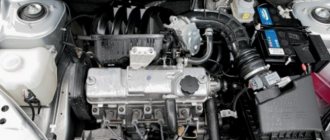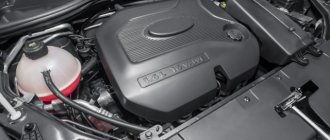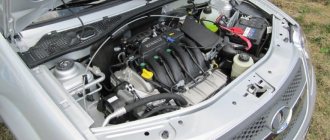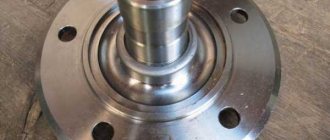What do you like
The engine pulls well from the bottom, and the difference with the 16-valve engine in terms of torque is small.
At the start there is no big difference between them. You shouldn't look at horsepower, as it doesn't affect acceleration dynamics. The 8-valve unit will not be enough only when the car is heavily loaded and the air conditioning is on. By the way, when it idles, you can feel a strong detonation in the body. It’s hard to say what will happen to the engine in 5 years. The suspension breaks, but not often. Its reliability is high; owners rarely repair the chassis. I don’t know why the windows are knocking, they are completely closed.
What do 16 valves give to an engine?
The eight-valve engine was the first to be produced by automakers. It has 4 cylinders, each of them contains an intake and exhaust valve. This engine option was produced by car manufacturers for a long time and had authority among car enthusiasts for its simplicity and low cost of maintenance.
The automotive industry developed and a 16-valve engine was released. It has two valves for intake and exhaust. The innovation of manufacturers ensured good performance of this type of engine, which caused a sensation among car enthusiasts.
Why the engine fires and why you need to quickly solve this problem - find out in this material.
You can see the five most durable cars here.
The difference between 8 and 16 valves in an engine is that an eight-valve engine has one camshaft, which controls the injection and exhaust system; the valves open alternately. The sixteen-valve engine has a more complex design. It has two camshafts, in one cylinder there are four valves, two of which work for intake, the others for exhaust. The function of the second camshaft is to rotate and control the gas distribution mechanism.
Advantages of an eight-valve engine:
- Simple design features facilitating simplified engine overhaul;
- Minimum costs for maintenance and repairs;
- Undemanding to the quality of oil and fuel
- The engine is compact and easy to maintain, as it provides access to all the elements that are installed on it.
Disadvantages of an eight-valve engine:
- Low power due to fewer valves;
- Increased fuel consumption due to the engine performing a long intake and exhaust process;
- Noise that makes itself felt while the car is moving at speed;
- The need for regular adjustment of valve clearances, which will protect against excessive fuel consumption.
This type of engine is considered simple and reliable. It can be filled with not the most expensive fuel and oil. However, the unit cannot please with its power and high speeds.
Advantages of a sixteen-valve engine:
- More powerful than an 8-valve engine - higher maximum speed and dynamics;
- Less fuel consumption;
- The presence of hydraulic compensators ensures minimal engine noise and no need to adjust the valves;
- Convenient timing belt replacement;
- Stable engine operation at idle and low speeds;
- Wide possibilities for tuning, the ability to install a turbine.
Disadvantages of a sixteen-valve engine:
- Expensive maintenance. It is recommended to operate the engine on high-quality synthetic oil;
- The complex structure of the engine, which complicates maintenance and major repairs.
Who should choose which engine?
The 16-valve engine will appeal to those who prefer high speeds and power, and dynamic driving. The 16-valve engine is more suitable for the city, where there will be a large number of service stations that will allow you to monitor and properly service this engine. The intake and exhaust elements of the sixteen-valve engine are located in different parts of the cylinder head, which opens up wide tuning possibilities.
The 8-valve engine option is preferable for people who do not have a “thick wallet” and do not live in rural areas with poor road surfaces. These car enthusiasts plan to repair the engine themselves in the event of a breakdown and prefer a leisurely, measured drive.
Lada largus 1.6 mt 105 hp
Technical data
The next 1.6-liter is a gasoline unit with a power of 105 horsepower. Unlike the previous two engines, in this engine the number of valves has been increased from 8 to 16. This type is installed on both the seven-seat and five-seat Largus.
Such a car accelerates to hundreds of kilometers in 13.5 seconds, which is 2 seconds faster than the 87-horsepower one. The maximum speed is 165 km/h, while fuel consumption is 11.5 liters in the urban cycle and 7.5 liters in the suburban cycle.
Despite the increased power, fuel consumption has decreased slightly.
Owner reviews
- Pavel, Moscow. After the birth of their fourth child in the family, his wife and I decided to take a more spacious car. Since funds were limited, I had to take a Lada Largus 1.6 MT (model year). In principle, we were satisfied. There is plenty of space in the car. Cons #8212 soft suspension, strong roll when cornering. Average consumption is 9 liters.
- Boris, Suzdal. I have already driven 14 thousand km and passed the first maintenance. So far there are no complaints. The main advantages are capacity and price. Among the shortcomings, I can name poor sound insulation, driving is not entirely comfortable, although the driver's seat is comfortable, high fuel consumption - 12-13 liters in the city and 9 liters on the highway.
- Nikolay, Voronezh. Lada (VAZ) Largus 1.6 MT. There are no analogues with seven seats and such spaciousness for such money. The handling is excellent, as is the suspension in general. There have been no breakdowns so far. The only thing that broke was the door handle. Fuel consumption per hundred in the combined cycle remains stable at 9-10 liters.
- Sergey, Astrakhan. There were already cars before this. Comparing with them, I can say that Largus #8212 is a good car. My mileage is about 350-400 km per day, in all the time (I bought a new one last year) there were no serious breakdowns. Consumption is also pleasing #8212 per hundred 8-9 liters in the city, 7 liters on the highway. The only “but” #8212 lacks 6th gear and good sound insulation, otherwise everything is in order.
- Evgeniy, St. Petersburg. I took the car under the recycling program. The first thing I noticed was the low price for such a package. Very practical. The clearance is huge and absorbs all the bumps on the roads. Consumption is about 9 liters. But there are also disadvantages: a bad gearbox - the first gears are a bit short, the low beam is weak.
Sales of Lada Largus Cross started at the beginning of the year. By its type, the new model belongs to the off-road version. This became possible thanks to the increased clearance between the car and the road. Unlike the standard model, Largus is 25 mm larger.
Body kits made of plastic were also added. The new Largus is available only in a luxury configuration and in two modifications: 5- and 7-seater. The cabin is equipped with two airbags, air conditioning and an on-board computer. There is 1 under the hood.
6-liter gasoline engine with a power of 105 hp.
Engine VAZ 21116 (11186)
The engine began its life with the advent of the Lada Granta car on the market and in the first years of production it was installed on the “Norma” version, while the younger model engine 11183 was installed on the “Standard” version. Unlike its predecessor, it received a significant number of qualitative changes, which allowed this engine win good reviews among customers as an economical, torquey and at the same time simple and reliable engine.
For the first time in the VAZ engine line, a final plateau honing of the cylinder block was used for an eight-valve engine, just as is done for the VAZ 21126 engine. Oil nozzles were also used for the first time in the cylinder block to cool the connecting rod and piston group. The group itself has become lightweight, similar to its 16-valve counterpart. As a result, it was possible to achieve a significant reduction in the mass and inertia of the SG group, which entailed a significant reduction in noise, vibration and fuel consumption, and also made it possible to increase power and torque. If the previous engine with a heavy piston group had a torque of 120 N/m and developed 81 hp, then the new engine already reached 140 N/m and 87 hp.
The cylinder head has also undergone changes; the engine’s compression ratio has been significantly increased, to 10.1 units; additional mounting points have appeared on the cylinder head for using an automatic timing belt tensioning system.
The gasket between the block and the head is now not impregnated textolite, but two-layer metal, which has significantly improved the tightness of the connection and eliminated most engines from oil leaks.
The introduction of new environmental standards required changing the fuel injection system and exhaust system using a neutral afterburner.
This engine on cars of the first years of production had the index 21116, later, without significant technical changes, it received the index 11186, maintaining all its indicators. According to some information, the change in the index is associated with a change in the supplier of the connecting rod and piston group; if in engine 21116 the supplier was Federal Mogul, then in the engine with index 11186 AvtoVAZ independently mastered the production of ShPG.
Lada larugs 1.6 mt 84 hp
Fuel consumption rate per 100 km
In 2008, AvtoVAZ bought a license to produce Renault engines. At the same time, the rights to produce cars from a French automaker called Lada were acquired. Under the hood of the Lada Largus there is a 1.6-liter power unit.
It has eight valves and a power of 84 horsepower. This engine is one of three in the line of power units and is equipped with a five-speed manual transmission. The maximum speed that such an engine can reach is 156 km/h.
New Lada: About the engine temperature of Lada Granta and Kalina 2
At the same time, its fuel consumption is 12.3 liters in the urban cycle and 7.5 liters on the highway.
Real gas consumption
- Sergey, Moscow. Lada (VAZ) Largus 1.6 MT. I am happy with the car. Just a monster compared to the VAZ 2115 that I owned before. I like the fact that it is very roomy, you can carry anything in the trunk. The only downside is that the wheelbase is long, it’s hard to drive over hillocks. At speeds over 80 km/h, the transmission begins to make a terrible noise. Consumption is 12.5 liters in the city and 8 liters on the highway.
- Julia, Kyiv. The car is ideal for transporting goods. Also very good for traveling with the family. At 30 thousand km, I noticed that the engine power began to drop. The service center changed the cuff and everything seemed to be fine. Fuel consumption in the summer on the 92nd is 9 liters, in the winter about 10 liters. I have a new Largus of the year with a 1.6 MT engine.
- Nikolay, Vologda. I have already driven 12,000 km in my brand new Lada Largus. Overall the car is not bad, but there are some disadvantages. After 8 thousand, reverse gear began to shift poorly. The trunk floor is uneven and the seats do not recline well. The onboard consumption of the 1.6 MT engine shows about 12.5 liters in the city and 8 liters on the highway. The positive thing is that there is high ground clearance and good suspension.
- Sergey, Tomsk. Lada (VAZ) Largus 1.6 MT. I took the car last year. During all this time I drove it mainly to work. Constantly carried cargo. After 11,000 km I'm still happy with the car. For such a price there are simply no shortcomings. Although in the first days of operation several fuses burned out and I don’t know why. Consumption is about 9.5-10 liters per 100 km.
- Victor, Kursk. After owning a six and an eight, I was surprised that the Lada Largus is a domestic car. I was very pleased with the purchase. For driving in rural areas - just what you need. Consumption is 9.5 liters per 100 km. The main drawback is the large gaps in the doors, because of this the cabin is constantly full of dust. Engine 1.6 MT, model of the year.
VAZ 21126 and 21127 - on Grants in the “luxury” configuration
with the 21126 engine, since it has been installed on Prioras for many years. Its volume is 1.6 liters and 16 valves in the cylinder head. The disadvantages are the same as the previous option - collision of pistons with valves in the event of a belt break. But there is more than enough power here - 98 hp. according to the passport, but in reality, bench tests show a slightly better result.
21127 is a new (pictured above) improved engine with 106 horsepower. Here this is achieved thanks to a modified, larger receiver. Also, one of the distinctive features of this engine is the absence of a mass air flow sensor - and now instead of it there will be a DBP - the so-called absolute pressure sensor.
Judging by the reviews of many owners of Grants and Kalina 2, which have already had this power unit installed, the power in it has actually increased and this is felt, especially at low speeds. Although, practically no elasticity has been added and in higher gears the acceleration does not occur as quickly as we would like.
Despite the fact that the Lada Granta is a budget car, the manufacturer offers a wide range of engines for it:
Of course, the volume of the engines listed above is approximately the same and is 1.6 liters, but each of the listed power plants has its own advantages and disadvantages. For this reason, many car enthusiasts who want to purchase a Lada Granda often cannot decide on the type of engine they need, and therefore below we will try to consider each of them.
Eight-valve k7m 800
} myth engine model Lada Largus borrowed from Renault Logan and Sandero. They are completely similar. For the first time, the myth unit began to be installed on the foreign cars indicated above in 2021, then it was a little stronger, however, due to certification according to the Euro-4 standard, its design was revised. The engine lost three horsepower, and its power became 83.
A positive point about the eight-valve unit is that its service life, according to direct information from the manufacturer (Renault), is more than 400 thousand km. We note the shortcomings of this engine based on the experience of using it not only on the Lada Largus car, but also on the Logan:
Choice of 1.6 liter engine. 8 or 16 valve
Andrew:
On a medium-loaded 8-valve car, 3200 rpm at 120 km/h is a pipe dream for the owners of 16 valves. You talk to passengers without raising your voice, the noise is mainly from tire studs. It’s easy, by the way, to accelerate further. I’m afraid to think what will happen after the break-in and chips.
- We kindly ask you to tell us in more detail how the standard behaves with an 8-cl engine.
- A lot is written about suites, but there are practically no reviews about the standards.
- The norm is preferable because the air conditioner is completely unnecessary (power steering too, if it were possible, I would also remove it right away).
I am mainly interested in driving on the highway, from 90 to 110 a loaded and not very loaded car (on a flat road, uphill, overtaking up to 130. 140) - what gears, what speed is obtained, etc.
Your feelings are especially important - at what point does it begin to feel like the car is running with tension (does this even exist, or is it just a fairy tale?)
Exclusively my opinion. As I wrote earlier, I needed the car urgently and therefore grabbed what was available. Up to 3000 km it consumed gasoline shamelessly. After 5000 it went more fun (apparently I lost that weight on the way) Now the mileage is 11000, I installed an LPG so as not to worry about refueling. Just up to a speed of 110, my Lavrenty, even with 8 valves, runs quite well.
The same slippage on the first, as the owners of 16 cl. write. Moreover, loading has virtually no effect. But after 110 the dynamics are different and the appetite is different, which is why I don’t drive faster. Otherwise, I'm happy with the car, it's definitely worth the money. I repeat IMHO. 84hp is enough for me. Yes, and it is cheaper to maintain, the engine itself is unpretentious, and you can write a lot.
That's it.
White Norma 7 places call Lavrentiy Palych (The taste is green)
Engine
This is a standard 186 modified engine. Lightweight piston group. Previously, the valves on them could bend if the timing belt broke. But in the new Lada Granta on all engines the valves no longer bend - the pistons are plugless. These are not capricious motors, repairable, spare parts are inexpensive. But they do not have hydraulic compensators, so the valve clearances need to be adjusted (every 30,000 km).
New Lada: Why the engine does not develop speed
A 5-speed manual transmission is installed, which has been used for many years. But the noise from the gearbox is much reduced, especially in 2nd gear. The engine has some advantages over 16 valves. In terms of the cost of a car with different engines, the difference is only 15,000 rubles.
Motor series 21114
The 114th Lada Granta engine is available for standard equipment; some drivers update its electronic control unit. Chip tuners and diagnosticians calibrate the engine and sometimes change the program code. After well-performed 30 to 1000 calibrations, the car becomes more maneuverable and the engine runs smoother.
The torque and power of the motor also increase. Fuel consumption is sharply reduced. There are many advantages, but there is only one drawback: it is better not to do excessively frequent calibrations (as well as tuning performed by a non-professional) - this can lead to a deterioration in all of the above indicators.
This engine came from the Lada Kalina. Its volume is 1.6 liters, and it has 8 valves. Although its power is small, it is the most torquey of all domestic engines. People experience virtually no discomfort while driving. In this case, before doing chip tuning, you should decide what is more important: speed and fuel consumption or a comfortable ride.
Another big advantage of this engine is the reliability of the gas distribution mechanism.
Often, if the timing belt breaks, you can replace it on the road without problems and continue your trip to the nearest inspection station. This is due to the fact that in this engine the valves do not collide with the pistons and, accordingly, do not bend. This means that the operation of the engine itself is practically undisturbed. In addition, it is very easy to maintain due to the fact that its design is identical to the engine from the VAZ 2108 (except for the increased volume). And to increase maneuverability and reduce fuel consumption, some drivers order chip tuning (firmware of the electronic control unit).
Lada Largus 1.6 MT 87 hp
Official information
If the 1.6 engine (84 hp) is installed on a Lada Largus with 5 seats, then under the hood of a seven-seater car you can see essentially the same petrol 1.6-liter 8-valve with a slightly increased power to 87 horsepower.
Just like the previous power unit, this engine is paired with a 5-speed manual gearbox and can accelerate the car to a top speed of 155 km/h. At the same time, the acceleration time from zero to hundreds of km is 15.
4 seconds, and fuel consumption per 100 km in the urban cycle is 12.4 liters and on the highway - 7.7 liters.
Fuel consumption on Russian roads
- Victor, Belgorod. Lada (VAZ) Largus 1.6 MT. As for me, the car is so-so. Doesn't justify itself. Firstly, the on-board computer is antediluvian. On Kalina it’s even better. Secondly, after six months all the chrome plating peeled off. It is unclear why the fog lights were installed, since they are of no use. The consumption is high - more than 12 liters per 100 km in the city, and this is only in the summer.
- Renat, Naberezhnye Chelny. The car is good, but only if you plan to use it for work and transporting cargo, and traveling with your family. The luggage capacity of the Lada Largus (version of the year) is enormous, especially when a row of seats is folded down. Consumption in the city is 12-13 liters, on the highway 8 liters. It’s bad that due to the lack of a filter in the stove and rubber bands between the doors, the cabin is full of dust.
- Olga, Lipetsk. The car was rented last year for long trips and transporting large dogs. Under these criteria, Largus 1.6 MT 87 hp. justified himself. One of the disadvantages is the long body, which is not very convenient in the city when making turns and parking. Also expensive to maintain. Consumption is within 12 liters in the city, outside the city 8-9 liters maximum.
- Ilya, Peter. Lada Largus 1.6 MT. I found no flaws in this car #8212 a good workhorse. It contains a car, an SUV, and a truck. I've been looking for exactly this for a long time. The design is excellent and, in my opinion, not typical for our automobile industry. The engine is powerful and pulls well. The consumption is a bit high, but it will do for such a car. On average 9-10 liters per 100 km.
- Elena, Smolensk. For a family living outside the city, this is the ideal car. He is a reliable assistant both at work and at leisure. I am one hundred percent satisfied, because for such a price it has many more advantages than expected. The 1.6 engine is good; it consumes no more than 8 liters per hundred kilometers on the highway. In the city the computer shows 12 liters.
Lada Granta: 8 valve or 16 valve?
Good morning everyone. We decided to buy a Lada Granta for the family. We decided on the color and body. Here's the issue with the motor. 8 or 16 valves?! Our family is obese, I’m afraid that when fully loaded the car will be very slow to accelerate. And it seems like 16 is quieter and more economical?! but almost 50 more expensive(((I would like to hear the opinions of people with operating experience.
8 valve is good in the city, 16 valve is good on the highway, for long overtaking (American trucks) 8 valves will be weak. If you have everything full, it’s not worth saving for 50 thousand, it doesn’t make a difference.
0 0 Answer rating: 0
You will hardly feel the difference! When overtaking trucks, you will still have to switch to a lower gear! I generally have 82 horsepower, I don’t really worry, I’m loaded along the highway for 1200 km in 15 hours, overtaking trucks, chickens, cars, etc. True benz 95! And in the city I surprise many with its dynamics, because the engine drags from the bottom)
0 0 Answer rating: 0
When the valve breaks, the timing belt bends on both. But on an 8-valve engine it’s easier to get close to the engine, there’s less unnecessary plastic. I would recommend the 8 valve. But both motors pull normally and the same. If you roll it in normally, don’t force it
0 0 Answer rating: 0
Take 16.5 people in the cabin and 30 kilos in luggage with included air conditioning up to 170 km per hour easily
0 0 Answer rating: 0
You need to take a 16 cl, it’s more economical and faster, it’s fast in the city and on the highway, and there’s a power reserve left, this is the last century 8 cl, all new cars are almost foreign cars, equipped with these engines, I don’t see the point of taking an 8 valve, they take those that haven’t driven on them or who had a dead motor
0 0 Answer rating: 0
For the purpose of servicing yourself, it’s cheaper and much easier to use 8 cl. There was a viburnum 16kl. sold, bought Grant 8kl. happy as an elephant, no problems
0 0 Answer rating: 0
I switched to 16 valves more than a year ago and still miss the blast at the bottom of 8 valves, I really miss it in the city/traffic jams/loaded
0 0 Answer rating: 0
8kl 87hp, on the May holidays I drove from Omsk to Chelyabinsk and back, 950km - 12.5 hours. Loading about 300kg. I drove around trucks in 5th gear at 80 km/h confidently, with a lack of space from 4th gear. I was pleasantly surprised! I don’t understand who needs 87 hp. And when it’s fully loaded, I think there’s no point in accelerating it too much, because the handling and braking from the engine don’t change!
0 0 Answer rating: 0
Take 8 valves. With a heavy load there is more traction. 16 valves will have to be turned. Owned both engines.
0 0 Answer rating: 0
VAZ assures that the FL Grants (apparently a facelift) will not bend valves since 18 - neither 16 nor 8 (grooves), and the main gear of the box has been changed from 3.7 to 3.9 - a little faster. I myself have 8 grades. running-in For 87 hp it doesn't go bad. Only almost every official maintenance is noticeably more expensive than 16 cl... We'll see...
0 0 Answer rating: 0
Lada Largus fuel consumption 8, 16 valve engines
In the middle of the year, the Lada Largus series car was presented to the public. The production of this model is a joint project between VAZ and Renault. Thus, the release of 70 thousand copies was initially planned.
According to its concept, Largus is a version of the Dacia Logan car, adapted for Russia, produced in Romania since 2006.
There are three versions of the Lada Largus, which is produced today: a station wagon (R90), a station wagon with increased capacity and a cargo van (F90).
Reviews
Motors Lada Largus
What kind of motor is it? Here, the manufacturer also did not rush to extremes and, without a shadow of hesitation, used power units from Logan.
These are two versions of engines with a similar volume of 1.6 liters:
- 8-valve version “K7M”, capable of producing 86 hp. With.;
- its modification “K4M” has a 16 valve engine, the output of which is 105 “horses”.
New Lada: Lada Granta fuse and relay block diagram
AvtoVAZ made its contribution by offering the 11189 power unit installed on Vesta. Let’s be honest, this engine was already installed on the Grant, but only here it was “brought up” to comply with the Euro-5 standard.
We are most interested in a “couple” of competing engines: a 16-valve engine versus the domestic 8-valve unit “11189”.
How do owners respond to the engines of their Lada Largus station wagons? Today's Internet is overloaded with a variety of information regarding both equipment options for the Lada Largus. We tried to select the most worthy reviews for the intriguing rivalry we are considering. And also figure out who has which motor?
Which Lada Granta engine is better?
If you buy a Lada Granta car, which engine is better to choose? This question interests many future car owners. Every buyer wants to purchase a maneuverable, powerful, controllable and fast car. And not everyone has the desire to do engine chip tuning.
The domestic automaker produces a grant with 5 types of engines. Not every driver knows which engine to choose, since Grant engines differ from each other not only in their advantages, but also in their disadvantages. Therefore, when choosing, it is better to immediately evaluate all the pros and cons.
Differences between series 21116 and 11186
One of the most popular engines is the 21116 series unit. The domestic manufacturer produces cars with this engine under the hood. It is provided for the standard Lada Granta configuration.
This engine has an imported piston system designed for any kind of firmware. A huge disadvantage of this unit is that when the timing belt breaks, the valves automatically bend. The power of the 116th engine according to documents is 90 hp. pp., in reality, drivers achieve higher rates.
The difference between this type of internal combustion engine and the 11186 series engine is that the latter is derated by 3 hp. With. to reduce detonation. The second no less important distinctive feature of the 11186 engine is that its piston system is a domestic product. The 11186 series internal combustion engine has been developed in accordance with the international environmental standard EURO-4 for the regulation of harmful substances in exhaust gases. Usually people prefer to do chip tuning to strengthen these engines.
Manufacturers called the 21116 engine series an upgrade of the previous 114 series. The changes affected only the installation of a lightweight connecting rod-piston system. One of the features of a breakdown is that the pistons break into several parts. This is due to the fact that the new pistons are lighter and thinner; when they encounter valves, they break. Connecting rods often break as well. The total cost of repairs in such cases can reach or even exceed half the cost of a Lada Grant engine.
However, lovers of maneuverability in driving will like this engine more than 21114. It is 6 hp stronger. With. and is much quieter. As a result, additional chip tuning and noise insulation may not be required. It all depends on the wishes of the driver.
Motor series 21114
The 114th Lada Granta engine is available for standard equipment; some drivers update its electronic control unit. Chip tuners and diagnosticians calibrate the engine and sometimes change the program code. After well-performed 30 to 1000 calibrations, the car becomes more maneuverable and the engine runs smoother.
The torque and power of the motor also increase. Fuel consumption is sharply reduced. There are many advantages, but there is only one drawback: it is better not to do excessively frequent calibrations (as well as tuning performed by a non-professional) - this can lead to a deterioration in all of the above indicators.
This engine came from the Lada Kalina. Its volume is 1.6 liters, and it has 8 valves. Although its power is small, it is the most torquey of all domestic engines. People experience virtually no discomfort while driving. In this case, before doing chip tuning, you should decide what is more important: speed and fuel consumption or a comfortable ride.
Another big advantage of this engine is the reliability of the gas distribution mechanism.
Often, if the timing belt breaks, you can replace it on the road without problems and continue your trip to the nearest inspection station. This is due to the fact that in this engine the valves do not collide with the pistons and, accordingly, do not bend. This means that the operation of the engine itself is practically undisturbed. In addition, it is very easy to maintain due to the fact that its design is identical to the engine from the VAZ 2108 (except for the increased volume). And to increase maneuverability and reduce fuel consumption, some drivers order chip tuning (firmware of the electronic control unit).
Series 21126 and 21127
Often, when buying a luxury Lada Granta, buyers think about which engine is better. In this case, you should also decide what the buyer is willing to sacrifice: power (which he can boost by tuning the Lada Granta engine) or the high cost of engine repairs.
Engine 211126, also installed on the Lada Priora, has a volume of 1.6 liters and a 16-valve cylinder head (cylinder head) system. If the buyer does not want to deal with the problem of bending valves, it is better to choose a different motor. The advantage of this engine is its high power. According to the passport data, it is 98 liters. s., but tests on stands showed higher results.
For fans of engines with absolute pressure sensors instead of a mass air flow sensor, it is better to choose 21127. This engine has 106 horsepower, which is provided by a modified and larger receiver, this power is felt, especially at low speeds. The car is more dynamic when overtaking or making a sharp start.
Page 2
This section contains such information about the car that you simply cannot do without. The features of the beloved Lada Granta are not known to all owners of the car. Here you can find the most complete information on the configuration of a particular Grant model, find out how the various car systems are designed. Our experts will tell you about the features of car production and its basic characteristics, and here you will find information on how to improve them.
home
Comfort package overview
The car is equipped with an 8-valve engine producing 87 hp, the equipment can be called average. I like the silver color. The cost is 522,500 rubles including paint. If the color is white, the price will drop by 6,000 rubles.
The car has a small set of options, but the most necessary ones are there:
- Air conditioner.
- Electric power steering.
- Electric windows.
- 2 airbags.
- Heated seats.
We won’t pay much attention to the configuration; everyone already knows about this.
New Granta: how is it really better than the old one?
Buyers of inexpensive cars count every penny and do not want to listen to discussions about rising prices: why do we care that localized components are produced using imported equipment and often from imported raw materials? And how can one not pay attention to the conversations of armchair experts that AVTOVAZ is profiting from consumers and that the red price for Grant is two hundred thousand, maximum two hundred and fifty?
In reality, with a price range from 420,000 to 634,000 rubles, the Granta remains the most affordable new car. As of December last year, the Grant family, with the former Kalinas - hatchback and station wagon - joining its ranks, took first place in sales in Russia. You can slander as much as you like, but the winners are not judged - even if they are not chosen for fat.
The pre-restyling editorial Grant ran more than 100,000 km. The eight-valve engine (87 hp) has retained sufficient vigor for driving around the city, which means there will be no problems with it in the new car.
Granta has been produced since 2011; the editorial machine rolled off the production line in 2012. Its engine is the simplest - an eight-valve engine with a lightweight connecting rod and piston group. The only bells and whistles are air conditioning and electric front windows. An excellent option for checking the extent of progress over seven years of life. We pitted two brand new Grants against the editorial worker - a sedan with a manual transmission and a liftback with an automatic transmission.
problem Grants is an outdated platform. Slurred driving habits, weak steering... You can play with the suspension characteristics, but a miracle will not happen. The restyled car, which has only a couple of thousand on the odometer, has not become any better even compared to the tired editorial sedan, which has more than 100,000 km behind it.
The force on the steering wheel is stepped, there is no feedback, the reaction to the rotation of the steering wheel comes late, the rolls are scary. But the incredible energy consumption of the suspension has not gone away: you can drive away without dismantling the road. The center console is different only stylistically. The configurations have acquired a clear structure: buyers of cars with bodies of all four types are offered the same set of options. Grante's navigation is no longer allowed in principle. The automatic is now available for cars in not only Comfort, but also Luxe versions.
The stabilization system is available in the top version of Luxe Prestige, and on Grants with an automatic transmission it is also available in the Comfort package.
The center console is different only stylistically. The configurations have acquired a clear structure: buyers of cars with bodies of all four types are offered the same set of options. Grante's navigation is no longer allowed in principle. The automatic is now available for cars in not only Comfort, but also Luxe versions.
The stabilization system is available in the top version of Luxe Prestige, and on Grants with an automatic transmission it is also available in the Comfort package.
The seats have two-tone upholstery in the Vesta style and a modified profile. It's prettier, but still uncomfortable. There is clearly a lack of lateral support. Adjusting the seat height (a privilege of the luxury version) does not help: you desperately want to sit much lower.
The seats have two-tone upholstery in the Vesta style and a modified profile. It's prettier, but still uncomfortable. There is clearly a lack of lateral support. Adjusting the seat height (a privilege of the luxury version) does not help: you desperately want to sit much lower.
general information
The Lada Largus station wagon went on sale for the first time in 2020. It is available in two versions - for transporting passengers or cargo. Car owners are more interested in the passenger version, which, according to the manufacturer’s idea, can accommodate 5 or 7 people. When developing this model, increased attention was paid to such features as:
- speed;
- comfort of the driver and passengers;
- smooth ride.
The engines for this purpose were made by the Renault concern and are designed for use in the Russian climate. Any engine installed on a Lada Largus car is used in the following conditions:
- winters;
- off-road;
- sharp temperature fluctuations.
Similar engines are installed on adapted Renault and Nissan models. Regardless of the valve accounting system, the engine on the Lada has a volume of 1.6 liters and an electronically controlled distributed fuel injection system. The engines work in pairs with a manual transmission, because the manufacturer decided not to use an automatic transmission on the Lada Largus.
A special feature from the Russian manufacturer was the introduction of only gasoline engines running on the AI-95 brand.
AvtoVAZ specialists explained this by saying that despite the lower price of diesel fuel, the assembly and service of diesel engines will cost more. Insignificant savings on fuel are unprofitable for both producers and consumers.
In terms of environmental friendliness, the joint creation with Renault-Nissan allowed Largus to pass testing for compliance with the Euro-4 standard.
The manufacturer has set a service life of 160 thousand km for each engine of this car. After this mark, you may need repairs; alas, with proper care, the Lada Largus can simply drive for even longer without stopping. Moreover, in the passports other numbers indicate who the engine is.
VAZ 21114 - stands on the Grant “standard”
This engine was inherited by the car from its predecessor, Kalina. The simplest 8-valve with a volume of 1.6 liters. There’s not much power, but there certainly won’t be any discomfort while driving. This engine, however, is the most torquey of all and pulls like a diesel at the bottom!
The biggest advantage of this engine is that it has a very reliable timing system and even if the timing belt breaks, the valves will not collide with the pistons, which means that you can simply change the belt (even on the road), and you can drive on. This engine is the easiest to maintain, since its design is completely identical to the well-known unit from 2108, only with an increased volume.
If you want to avoid problems with repair and maintenance, and not be afraid that the valves will bend if the belt breaks, then this choice is for you.
Trunk is too big
This thing is not clear. For example, I bought a car and I know that it will be driven by 2 people in front and the same number in back. Why make a huge trunk with a volume of 520 liters, and infringe on the rear passengers? Their feet are resting on the front seat backs!
There are companies that make large vans (firefighting, medical) on the Lada Granta chassis. Why make a huge trunk in a sedan and infringe on passengers?! It can be reduced and made like Vesta’s - 450 liters. This is quite enough.
Sixteen-valve k4m
This popular rumor is an engine with a power of 105 hp. With. installed on seven-seater station wagons and used in luxury configurations. It has significant differences from its brother with eight valves:
- Fuel consumption in mixed mode is about 9 liters. per 100 km;
- quiet operation;
- no vibration.
If you can think about which unit is better for Largus, then you should take a close look at the option with sixteen valves. It is more complex, because the price of a car equipped with such an engine will be slightly higher.
Servicing a sixteen-valve engine will also cost you a lot of money, but you can easily and simply drive it for more than 450 thousand km.
The main thing is to take care of it, listen to the advice of professionals 100%, change the components just in time and not even give it a very high load.
- skipping speed using low quality fuel;
- missing dynamics;
- expensive spare parts;
- the highest prices for service in service centers.
If you combine two engines, then, of course, the K4M is more profitable, because it does not require frequent valve adjustments. Its shortcomings are not so significant, like the eight-valve K7M.











